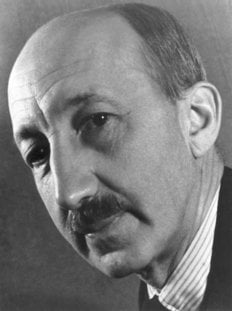George de Hevesy
Biographical

George de Hevesy was born in Budapest on August 1st, 1885, the son of Louis de Hevesy, Court Counsellor and Eugénie, née Baroness Schosberger. After matriculating at the Gymnasium of the Piarist Order in 1903 he studied at Budapest University and Berlin Technical University and he gained his doctor’s degree at the University of Freiburg im Breisgau in 1908. He worked for two years as an assistant at the Institute of Physical Chemistry, Technical University of Switzerland before having a short spell with Professor Fritz Haber when he was able to witness much of the fundamental work of Haber and Rossignol on ammonia synthesis. He travelled to England in 1910 to study under Professor Ernest Rutherford at Manchester. He interrupted early in 1913 his studies to carry out jointly with Frederic Paneth the first radioactive-tracer experiment at the Vienna Institute of Radium Research. During his stay in Vienna he obtained the Venia Legendi in the University of Budapest. In 1915 he was drafted into the Austrian-Hungarian Army. After the end of the war he was teaching for 6 months in the University of Budapest and left the spring of 1919 for Copenhagen to discuss his future activities at Niels Bohr‘s Institute which was to be erected. In 1920 he settled in Copenhagen.
Six years later he returned to Freiburg as Professor of Physical Chemistry. In 1930 he was appointed Baker Lecturer at Cornell University, Ithaca. Four years later he took up again his activities at Niels Bohr’s Institute which he terminated in 1952. He was domiciled in Stockholm since 1943 and was an Associate of the Institute of Research in Organic Chemistry. In 1949 he was elected Franqui Professor in the University of Ghent. In his retirement, he remains an active scientific associate of the University of Stockholm.
His early investigations involved a study of the chemical behaviour of molten salts and his introduction to practical radiochemistry came in Rutherford’s laboratories at Manchester. His work there, and later in Vienna and Budapest, mainly concerned the investigation and use of radium and lead isotopes.
In Copenhagen, de Hevesy’s researches were initially concerned with isotopic separations and in 1923, together with Coster, he discovered the element hafnium. He was responsible for pioneer work in the use of isotopic indicators both in inorganic and life sciences and later, in Freiburg, he was involved in the first clinical use of isotopes. On his return to Copenhagen, he demonstrated the formation of new artificially radioactive isotopes and subsequently introduced a method of activation analysis based on neutron bombardment of the element to be investigated. This method was to replace X-ray analysis with fluorescent X-rays which he introduced during his stay in Freiburg. The year 1934 saw the beginning of numerous investigations in the field of plant and animal physiology, using labelled atoms: these researches were supported by generous grants made by the Carlsberg Foundation, the Rask-Ørsted Foundation, the Rockefeller Foundation and others. His work in Sweden has continued on the same lines and he has studied, amongst other things, the effect of X-rays on the formation of nucleic acid in tumours and in normal organs, and iron transport in healthy and cancerous organisms; this work is supported by the Swedish State Research Council and the Wallenberg Foundation.
Professor de Hevesy is the author of several important books on radiochemistry and his many scientific papers are valuable and accurate records of devoted work. He was awarded the Cannizaro Prize (Academy of Sciences, Rome) in 1929, he was the Copley Medallist (Royal Society, London) in 1949, Faraday Medallist in 1950, Baily Medallist in 1951 and Silvanus Thompson Medallist in 1955. In 1959 he received the Ford Foundation’s Atoms for Peace Award Medal, in 1961 the Niels Bohr Medal and the Rosenberger Medal of the University of Chicago. Honorary degrees conferred upon Professor de Hevesy include Doctor of Philosophy, Uppsala, Freiburg, and Copenhagen; Doctor of Science, Ghent, Liège, London, and Capetown; and Doctor of Medicine, São Paulo, Rio de Janeiro, Turin, and Freiburg. He is a Fellow of the Royal Society (London), the Swedish Academy of Sciences, Gothenburg Academy, and eleven other scientific academies. He is Honorary Fellow of the Chemical Society (London), the Royal Institution (London), the British Institute of Radiology, the Finnish Chemical Society, the German Bunsen Society, the German Physiological Society, the Chemical Society of Japan, and the American Society of Nuclear Medicine. In addition, he holds honorary memberships of many more learned societies.
Professor de Hevesy married Pia Riis in 1924. They have one son and three daughters.
This autobiography/biography was written at the time of the award and first published in the book series Les Prix Nobel. It was later edited and republished in Nobel Lectures. To cite this document, always state the source as shown above.
George de Hevesy died on July 5, 1966.
Nobel Prizes and laureates
Six prizes were awarded for achievements that have conferred the greatest benefit to humankind. The 14 laureates' work and discoveries range from quantum tunnelling to promoting democratic rights.
See them all presented here.
